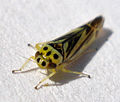Typhlocybinae is a subfamily of insects in the leafhopper family, Cicadellidae. This is currently the second largest leafhopper subfamily based on the number of described species, but researchers believe there are so many taxa yet undescribed that it is probably the largest subfamily.[1] Approximately 6000 species have been described thus far.[1]
Typhlocybinae belongs to the second-largest subfamily of leafhoppers, with >6,000 described extant species placed in ~300 genera and five tribes.[1]
Many species of the subfamily Typhlocybinae are major pests of crops, such as cotton, grape, and eggplant, by direct or indirect damage[2] (Oman, 1949, Vidano, 1962, Nielson, 1968, Zhang, 1990, Qin and Zhang, 2008).
Tribes
Entomologists divide the subfamily into four to ten tribes. Five tribes are generally accepted:[1]
Selected genera
- Alebra
- Dikrella[3]
- Dziwneono
- Empoasca
- Erasmoneura Young, 1952
- Eupteryx
- Jacobiasca
- Sweta Viraktamath & Dietrich, 2011[4]
- Typhlocyba
Gallery
References
- ^ a b c Dietrich, C. H. (2013). South American leafhoppers of the tribe Typhlocybini (Hemiptera: Cicadellidae: Typhlocybinae). Zoologia (Curitiba) [online] 30(5) 519-68.
- ^ Oh, Jung, Sumin, Sunghoon (1 March 2020). "Two new records of the subfamily Typhlocybinae (Hemiptera: Auchenorrhyncha: Cicadellidae) from Korea". Journal of Asia-Pacific Biodiversity. 13 (1): 115–119 – via Science Direct.
{{cite journal}}: CS1 maint: multiple names: authors list (link) - ^ Coelho, L. B. N., et al. (2014). A new species of Dikrella Oman, 1949 (Hemiptera: Cicadellidae: Typhlocybinae) found on Caryocar brasiliense Cambess. (Caryocaraceae) in Minas Gerais State, Brazil. Psyche 2014 871605.
- ^ Viraktamath, C. A. & C. H. Dietrich. (2011). "A remarkable new genus of Dikraneurini (Hemiptera: Cicadomorpha: Cicadellidae: Typhlocybinae) from Southeast Asia". Zootaxa. 2931: 1–7. doi:10.11646/zootaxa.2931.1.1.






Recent Comments